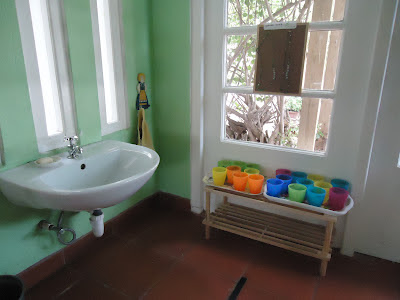One thing I'm thinking of introducing: Positive self time outs. I was talking with a parent from our school some months ago about my thoughts on "time out", and how ineffective it seems to me to isolate a child when they lack social skills, how little it teaches a child, and how much it just seems like old fashioned punishment. She mentioned the idea of approaching "time out" as a positive thing, as in "let's take some time out from this situation to calm down together" instead of "if you do that again I'M GOING TO PUT YOU in timeout." I kept on thinking about her words, and the idea of walking out of a situation willingly to calm down. Even as an adult to be able to say "I'm going to take a little time out for myself" and be able to remove ourselves from something that is making us upset or tired or whatever feeling is not working for us. How elemental and what an important skill to develop. I imagine an area in our classroom where children can take themselves to just for the purpose of self soothing. It would be an easy lesson to teach, and it would be very interesting to see if children decide to use this area on their own.
What I have been doing this year when a child has been aggressive or antisocial has been to bring them next to me and helped them calm down. If another child was hurt, going to that child together to see if they are ok and modelling care for each other happens first. (One thing that really makes a difference to me is keeping my own energy neutral in the whole process. If I am angry during any part of the process they might reject it because it feels like punishment.)
For some children, touch and talking helps, others get very antsy when touched, and for some just to sit next to me as I breath deeply or talk to them works best. The priority is for the angry or upset child to calm down. Once they are relaxed, we often observe the environment together. Sometimes I bring attention to something particular that might have to do with the situation that just occurred. When it seems like the child is ready to reincorporate, they go. (The idea is that they learn to function in the group, and this can only happen with practice, a.k.a. BEING in the group as much as possible.)
I take note of the situation and later on give the grace and courtesy lessons for the skills that were needed.
This approach has worked really well for us this year. I am very pleased with the results so far.
One thing that surprised me as I've been moving away from punitive and conditional tactics and language, is to recognize that when a child has repeatedly done something very hurtful or damaging (and I am angry) I naturally divert to old habits of thinking. That the child should somehow "pay" for it, or repent, or experience something negative because of what they did. Like behaviorism and the way I was raised and educated- that if you do something wrong then you should experience a punishment for it so that you won't do it again. It takes so much time to cure the habit. I see more clearly now that when you do something hurtful and damaging you are already having a negative enough experience. It does not need to be compounded with some external punishment. It needs to be alleviated. Alleviated with understanding and with skills building.





